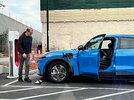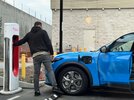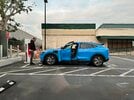I assume as well that this will lead to a substantial further build-out of the Tesla charging network, and perhaps that of other charging networks who might be, in the future, licensed to natively use NACS.
It's my understanding that Tesla released NACS as a fully open specification, with no strings attached, late last year. Prior to then, Tesla claimed that the Tesla connector (as it was then known) was free for anybody to use, but it had significant strings attached, so nobody would want to use it under those terms. Today, though, anybody can build a NACS product without licensing it from Tesla.
What's more, I know of two providers that have already announced they plan to add NACS connectors:
Freewire and
Flo. In addition, EVgo has long provided Tesla connectors via Tesla's CHAdeMO-to-Tesla adapter, but those are limited to 50 kW, and I'd expect they won't work with Ford and GM vehicles with NACS ports (assuming these EVgo adapter-based Tesla connectors are still in operation in 2025). I fully expect to hear more such announcements very soon.
It better lead to tones of 3rd party NACS stations. It would be a nightmare if there was a fast charging monopoly that emerged from this where Tesla was the only viable supplier and was also a gatekeeper for every EV (car and brand) being able to charge.
Agreed. This is the (potentially) dark side to this shift that's lurking in the back of my mind. Monopolies are rarely good for consumers. The potential positive take on this is that, because the current CCS networks will soon be
directly competing against Superchargers, it will force the current CCS providers to put more resources into improving site reliability. I'm not an expert on what's going on in Europe, but I get the impression that non-Tesla DC fast chargers there are more reliable than they are in the US, so it does seem to be possible using more-or-less the same hardware. (I'd be interested to hear from somebody with more direct personal experience of the charging situation in Europe.)
I also see an opportunity for some providers to specialize in ways that Tesla isn't doing. For instance, Tesla is focusing on larger and larger Supercharger sites; in the US, they now average at something over 10 stalls per site. (That average includes older installations; I don't know what the average size is for new sites.) There is room for smaller installations, though -- at out-of-the-way restaurants on small rural highways, at convenience stores and coffee shops in urban or suburban areas, etc. Some of these were the sorts of sites that EVgo and ChargePoint were focusing on five years ago, and with Tesla focusing on the big mega-sites, doubling down on the small-site strategy could give these competing networks some breathing room. OTOH, it may be easier to make the mega-sites profitable, so there may be challenges to this approach.
there will still be CCS signaling crap to work out.
That's a point that's getting overlooked. Some of the problems with the CCS networks relate to signaling incompatibilities caused by the complexity of the CCS protocols and the number of parties involved in implementing them. Tesla opening the Supercharger network to (potentially) any manufacturer that adopts NACS will make it subject to these same issues. That said, if non-Tesla automakers start designing with Superchargers in mind, they're likely to do extensive testing on Superchargers before releasing new vehicles, so reliability on the Supercharger network, at least, should be fairly good -- assuming Tesla doesn't constantly tweak the software on its end, in ways that might be disruptive.







